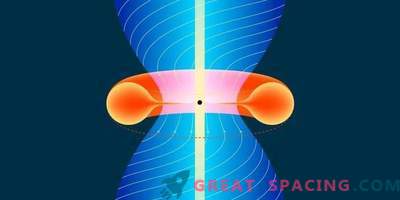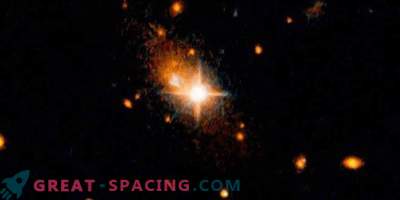
The computer model demonstrates a supermassive black hole in a galactic core. The black area in the center is the horizon of the black hole event, where light is not able to get out of the gravitational capture of a massive object. The powerful gravity of the black hole distorts the space around it, so the light of the background stars is stretched and smeared
Scientists from RIKEN and JAXA used observations from the radio observatory ALMA (Chile) to measure the magnetic field strengths near two supermassive black holes in the centers of galaxies. It is strange that the strength of the magnetic fields is not enough to power the "coronas" - clouds of superheated plasma around black holes.
Researchers have long known that supermassive black holes in galactic centers sometimes exceed their native galaxies in brightness and are endowed with corona of superheated plasma, resembling solar features. For black holes, these crowns are capable of heating up to phenomenal temperature indices of 1 billion degrees Celsius. For a long time it was believed that the corons are heated by the magnetic field energies, like those of the Sun. However, previously no one measured the magnetic fields around black holes.
Back in 2014, a group of researchers predicted that electrons in a plasma around a black hole would emit a special kind of light — synchrotron radiation. It must be in the radio band, that is, electromagnetic waves with a long wavelength and low frequency. Scientists decided to measure these fields. To do this, we reviewed the active galactic nuclei IC 4329A at a distance of about 200 million light years and NGC 985 at a distance of 580 million light years. The analysis was based on the observations of ALMA (Chile) and the Very Large Telescope. Conclusions suggest that the corona size reaches 40 Schwarzschild radii (the gravitational radius of a black hole, which does not even release light), and about 10 gauss in strength, which is slightly larger than the magnetic field on the Earth's surface, but smaller than a typical magnet per fridge.
The finding is that although we managed to confirm the synchrotron radiation from the corona in both objects, the magnetic field was too weak to support the intense corona heating. Noted also that conclusions concern both black holes, so can be the general phenomenon. Now scientists are planning to look for signs of powerful gamma rays that must accompany the radio emission in order to better understand what is happening in the environment near supermassive black holes.











































